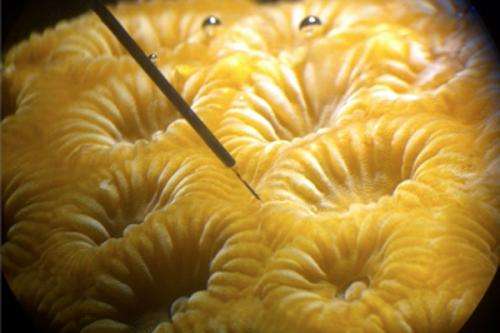Scientists shine a light on coral photosynthesis

(Phys.org) —Balancing budgets isn't just a matter for governments, as scientists have observed in a study of the way light is used in the symbiotic relationship between animal and plant that we know as coral.
Scientists from UTS and the University of Copenhagen have for the first time measured a balanced light energy budget for a coral – essentially the calculation of just how efficiently the coral's symbiotic microalgae use and regulate light in coral tissue.
The partnership between the coral polyp and the microscopic algae (zooxanthellae) provides the polyp with oxygen and other nutrients from photosynthesis in return for carbon dioxide and other substances the algae needs.
This new insight into the unique optical properties of coral paves the way for improved understanding of how environmental stress causes events such as coral bleaching and potentially how to better direct management resources.
Using innovative, advanced microsensor technology, researchers from the UTS's Plant Functional Biology and Climate Change Cluster (C3) and their University of Copenhagen collaborators measured the light energy budget of photosynthesising microalgae in coral, under healthy conditions, controlled in the laboratory.
The brain-shaped coral test species, Montastraea curta, is common to the Great Barrier Reef, inhabiting shallow reef flats. The challenging microscale approach of the research meant the team had to design an experiment that would allow them to measure light and oxygen by inserting microsensors as fine as one hundredth of a millimetre into coral tissue, in increments of a tenth of a millimetre at a time.
The results, published in the Journal of the Royal Society Interface, show that although the vast majority of light absorbed by the coral was lost as heat the microalgae actually use light highly efficiently during photosynthesis.
"This highlights the very special optical properties of corals. They appear to be very efficient light collectors and distributors," said lead author and C3 PhD candidate Kasper Elgetti Brodersen.
"This research is very timely as it strongly advances our basic concept of light and corals. We know that significant changes in local environmental conditions occur on a microscale, some corals are hotter and receive more light than others, although they are just next to each other.
"Using the techniques we've developed, future studies can now investigate this variability in a more detailed way, under different environmental conditions, and redirect management efforts towards the most susceptible corals."
Mr Brodersen said the study also provided further insight into the impact of elevated seawater temperatures, predicted under climate change, on coral health.
"The large amount of energy dissipated as heat means that coral light absorption can increase the temperature in the coral microenvironment relative to the surrounding water, potentially aggravating bleaching events," he said.
Journal information: Journal of the Royal Society Interface
Provided by University of Technology, Sydney




















